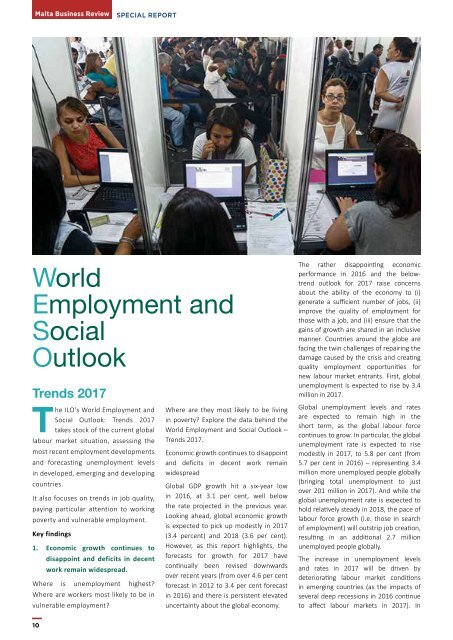MBR_Issue_27 -January 2017 low res
Create successful ePaper yourself
Turn your PDF publications into a flip-book with our unique Google optimized e-Paper software.
Malta Business Review<br />
SPECIAL REPORT<br />
SPECIAL REPORT<br />
Malta Business Review<br />
World<br />
Employment and<br />
Social<br />
Outlook<br />
Trends <strong>2017</strong><br />
The ILO's World Employment and<br />
Social Outlook: Trends <strong>2017</strong><br />
takes stock of the current global<br />
labour market situation, assessing the<br />
most recent employment developments<br />
and forecasting unemployment levels<br />
in developed, emerging and developing<br />
countries.<br />
It also focuses on trends in job quality,<br />
paying particular attention to working<br />
poverty and vulnerable employment.<br />
Key findings<br />
1. Economic growth continues to<br />
disappoint and deficits in decent<br />
work remain widespread.<br />
Where is unemployment highest?<br />
Where are workers most likely to be in<br />
vulnerable employment?<br />
Where are they most likely to be living<br />
in poverty? Explore the data behind the<br />
World Employment and Social Outlook –<br />
Trends <strong>2017</strong>.<br />
Economic growth continues to disappoint<br />
and deficits in decent work remain<br />
widespread<br />
Global GDP growth hit a six-year <strong>low</strong><br />
in 2016, at 3.1 per cent, well be<strong>low</strong><br />
the rate projected in the previous year.<br />
Looking ahead, global economic growth<br />
is expected to pick up modestly in <strong>2017</strong><br />
(3.4 percent) and 2018 (3.6 per cent).<br />
However, as this report highlights, the<br />
forecasts for growth for <strong>2017</strong> have<br />
continually been revised downwards<br />
over recent years (from over 4.6 per cent<br />
forecast in 2012 to 3.4 per cent forecast<br />
in 2016) and there is persistent elevated<br />
uncertainty about the global economy.<br />
The rather disappointing economic<br />
performance in 2016 and the be<strong>low</strong>trend<br />
outlook for <strong>2017</strong> raise concerns<br />
about the ability of the economy to (i)<br />
generate a sufficient number of jobs, (ii)<br />
improve the quality of employment for<br />
those with a job, and (iii) ensure that the<br />
gains of growth are shared in an inclusive<br />
manner. Countries around the globe are<br />
facing the twin challenges of repairing the<br />
damage caused by the crisis and creating<br />
quality employment opportunities for<br />
new labour market entrants. First, global<br />
unemployment is expected to rise by 3.4<br />
million in <strong>2017</strong>.<br />
Global unemployment levels and rates<br />
are expected to remain high in the<br />
short term, as the global labour force<br />
continues to grow. In particular, the global<br />
unemployment rate is expected to rise<br />
modestly in <strong>2017</strong>, to 5.8 per cent (from<br />
5.7 per cent in 2016) – rep<strong>res</strong>enting 3.4<br />
million more unemployed people globally<br />
(bringing total unemployment to just<br />
over 201 million in <strong>2017</strong>). And while the<br />
global unemployment rate is expected to<br />
hold relatively steady in 2018, the pace of<br />
labour force growth (i.e. those in search<br />
of employment) will outstrip job creation,<br />
<strong>res</strong>ulting in an additional 2.7 million<br />
unemployed people globally.<br />
The increase in unemployment levels<br />
and rates in <strong>2017</strong> will be driven by<br />
deteriorating labour market conditions<br />
in emerging countries (as the impacts of<br />
several deep recessions in 2016 continue<br />
to affect labour markets in <strong>2017</strong>). In<br />
fact, the number of unemployed people<br />
in emerging countries is expected to<br />
increase by approximately 3.6 million<br />
between 2016 and <strong>2017</strong> (during which<br />
time the unemployment rate in emerging<br />
countries is expected to climb to 5.7 per<br />
cent, compared with 5.6 per cent in 2016).<br />
Of notable concern are developments in<br />
Latin America and the Caribbean, where<br />
the unemployment rate is expected to<br />
rise by 0.3 percentage points in <strong>2017</strong>, to<br />
reach 8.4 per cent – largely driven by rising<br />
unemployment in Brazil.<br />
In contrast, unemployment is expected<br />
to fall in <strong>2017</strong> in developed countries (by<br />
670,000), bringing the rate down to 6.2<br />
per cent (from 6.3 per cent in 2016). In<br />
Europe, notably Northern, Southern and<br />
Western Europe, unemployment levels<br />
and rates are both expected to continue<br />
to fall, but the pace of improvement will<br />
s<strong>low</strong>, and there are signs that structural<br />
unemployment is worsening. The same<br />
applies to Canada and the United States.<br />
For example, in both Europe and Northern<br />
America, long-term unemployment<br />
remains elevated in comparison to precrisis<br />
levels and, in the case of Europe, it<br />
increased recently, despite the reductions<br />
in the unemployment rate. In fact, in the<br />
EU-28, the share of unemployed people<br />
who had been looking for a job for 12<br />
months or longer reached 47.8 per cent in<br />
the second quarter of 2016, up from 44.5<br />
What are the drivers of the global growth s<strong>low</strong>down?<br />
Several drivers have continued to underpin<br />
s<strong>low</strong> economic growth. In particular,<br />
subdued private investment and trade<br />
f<strong>low</strong>s have remained a major concern for<br />
both current economic conditions and the<br />
medium-term outlook. The trend decline<br />
in investment and trade is creating a large<br />
gap in aggregate demand, which cannot be<br />
fully offset by public spending because of<br />
the tight fiscal constraints (and is unlikely<br />
to be filled by private consumption due to<br />
sluggish employment and labour income<br />
growth). Moreover, forgoing investment<br />
today <strong>res</strong>ults in <strong>low</strong>er productive capital<br />
stock and productivity growth in the future,<br />
thus <strong>low</strong>ering income growth.<br />
• Weak productivity gains and slack investment<br />
growth are mutually reinforcing: S<strong>low</strong><br />
productivity growth and subdued aggregate<br />
demand – exacerbated by policy uncertainty<br />
in some large economies – continue to<br />
hold back private investment, especially in<br />
developed countries.<br />
per cent for the same quarter of 2012.<br />
Furthermore, in the second quarter of<br />
2016, more than two-thirds of this group<br />
– a total of 6 million people – had been<br />
unemployed for over two years.<br />
2. World Employment and Social<br />
Outlook – Trends <strong>2017</strong><br />
Unemployment levels in developing<br />
countries are also expected to increase in<br />
Low commodity prices are likely to continue<br />
to <strong>res</strong>train private investment in the<br />
extractive sectors, while overcapacity in<br />
some highly capitalintensive sectors is likely<br />
to constrain investment growth in China.<br />
Furthermore, fiscal policy remains tight in<br />
oil-exporter economies of the Arab States<br />
and in crisis-hit emerging countries (such<br />
as Brazil and the Russian Federation), which<br />
is likely to <strong>res</strong>ult in additional reductions in<br />
public investment in these countries.<br />
• Trade deceleration persists: As aggregate<br />
demand – especially the more tradeintensive<br />
components – remains weak,<br />
trade volumes are unlikely to pick up<br />
in <strong>2017</strong>. The global volume of trade in<br />
goods and services is estimated to have<br />
expanded by only 1.2 per cent in 2016,<br />
the s<strong>low</strong>est rate since 2009 and the third<strong>low</strong>est<br />
rate of trade growth over recent<br />
years.<br />
Source: UN DESA, forthcoming<br />
<strong>2017</strong> (by 450,000), with unemployment<br />
rates hovering at around 5.5 per cent in<br />
<strong>2017</strong> and 2018. For many developing and<br />
emerging countries, however, chronic<br />
poor-quality employment – as rep<strong>res</strong>ented<br />
by high sha<strong>res</strong> of own-account workers and<br />
contributing family workers (collectively<br />
classified as workers in vulnerable forms of<br />
employment) and working poverty – takes<br />
centre stage. <strong>MBR</strong><br />
Source: ILO’s Trends Econometric Models, November 2016.<br />
10 11<br />
www.maltabusinessreview.net

















